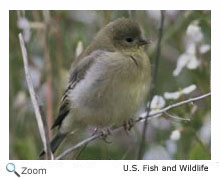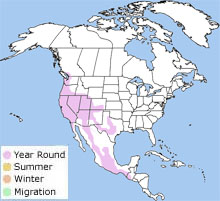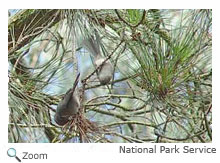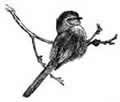Description
 The bushtit is about 3.5 inches in length and is one of the smallest birds in North America. It is pale gray to pale grayish-brown on its uppersides and whitish-gray on its undersides. It has a long gray tail, short legs, and a small pointed bill. Males and females look alike, but there are differences in the coloration and markings of bushtits depending on location.
Bushtits found in coastal areas have a brownish crown, inland birds have brown cheeks, and bushtits found in and near Mexico have black cheeks! The bushtit is about 3.5 inches in length and is one of the smallest birds in North America. It is pale gray to pale grayish-brown on its uppersides and whitish-gray on its undersides. It has a long gray tail, short legs, and a small pointed bill. Males and females look alike, but there are differences in the coloration and markings of bushtits depending on location.
Bushtits found in coastal areas have a brownish crown, inland birds have brown cheeks, and bushtits found in and near Mexico have black cheeks!
Range  The bushtit is found from southwestern British Columbia in Canada to southern Idaho, southwestern Wyoming, and the Oklahoma panhandle southward to Central America. The bushtit is found from southwestern British Columbia in Canada to southern Idaho, southwestern Wyoming, and the Oklahoma panhandle southward to Central America. |
|
Habitat
The bushtit is found in open deciduous and mixed forest areas. It is also found in suburban areas. It is a very social bird and travels in flocks of up to 60 birds during the non-breeding season.
Diet
Bushtits feed in flocks and move quickly through vegetation looking for insects and spiders.
They often hang upside down as they pick their prey from the undersides of leaves.
They call out with soft chirps to each other as they forage for food.
Life Cycle
 During the breeding season, bushtits form pairs and establish nesting territories. Their nests are up to a foot long and are pendulum-shaped. The nests have an opening in the top and hang from the branches of a tree or shrub. The nests are made of grass, twigs, leaves, moss, lichen, and various plant parts woven together with spider webs. The female lays 4-10 eggs, and both the parents incubate the eggs for 12-13 days. Both parents care for and feed the chicks. The chicks fledge when they are about 18 days old. During the breeding season, bushtits form pairs and establish nesting territories. Their nests are up to a foot long and are pendulum-shaped. The nests have an opening in the top and hang from the branches of a tree or shrub. The nests are made of grass, twigs, leaves, moss, lichen, and various plant parts woven together with spider webs. The female lays 4-10 eggs, and both the parents incubate the eggs for 12-13 days. Both parents care for and feed the chicks. The chicks fledge when they are about 18 days old.
Behavior
Bushtit nests are often decorated with flowers, feathers, and lichen! |



 The bushtit is found from southwestern British Columbia in Canada to southern Idaho, southwestern Wyoming, and the Oklahoma panhandle southward to Central America.
The bushtit is found from southwestern British Columbia in Canada to southern Idaho, southwestern Wyoming, and the Oklahoma panhandle southward to Central America.